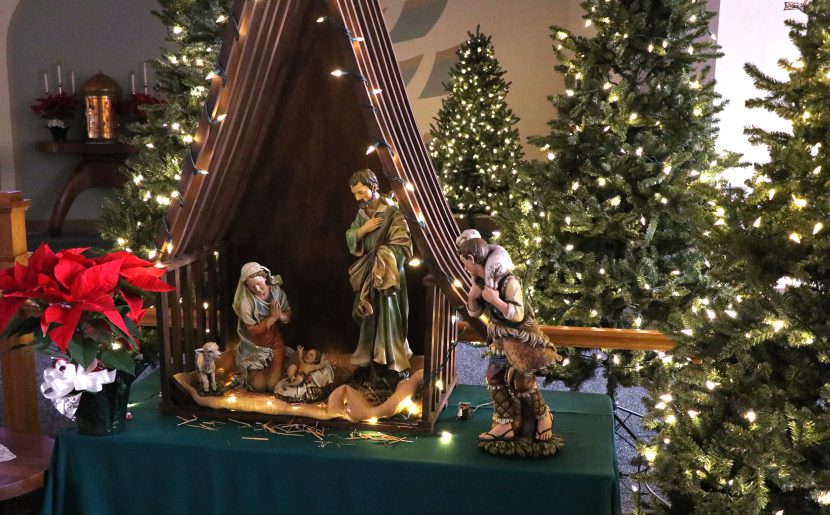Christmas Eve Blessing of the Crib

by Paulette Skiba, BVM
Christmas Eve Mass, December 2020
The Christmas stable is, in some ways, a harsh and mean place. It is the last resort of parents who have been displaced.
The Gospel is sparse in its details:
. . . She gave birth to her firstborn son. She wrapped him in swaddling clothes and laid him in a manger because there was no room for them in the inn (Luke 2:7).
Here it is that God says one irrevocable Word of Love: “I am with you. I am here.”
It is a night of wonder.
It is a night that beautifully brings to life the truth that surrounds us every day: heaven and earth are one.
Daily, we pray this as a hope in the Lord’s Prayer: “Thy kingdom come on earth as it is in heaven” (Matt. 6:10).
Christmas beckons us to linger on this truth. Tonight we gather with joyful hearts singing. It is too simplistic perhaps to put Christmas carols in two categories. But I will do it anyway.
There are the carols that place us in the company of the angels–these songs burst forth with the joy of a trumpet fanfare. “Glory to God in the highest and on earth peace” (Luke 2:14). These carols capture the joy that begins deep in the roots of the earth’s long waiting and bursts heavenward in delight. These carols lift us up and revive our spirits with God’s good news.
Then there are the carols that echo Mary’s songs to her infant son. Quiet, calming, sheltering–gentle tunes. They reflect the efforts of mother and father to transform this rough, cold place into a warm and safe home. For us, they reflect our efforts to welcome the dream God speaks in Jesus.
Our hearts are the real mangers of this night.
Given this year of so much hardship and loss, perhaps these softer songs speak to us in a special way. It seems to be a good year to reflect on the songs we sing in the night–although I know my spirit also needs to belt out “Joy to the World” and “Hark the Herald Angels Sing” during these Christmas days, even if imperfectly, alone in my room.
Written in the midst of the pandemic the December issue of National Geographic had an article about lullabies.[i] It was titled “Songs to Soothe” with the tagline: “In cultures around the world, the lullabies that coax children to sleep are windows into parents’ hopes, fears, and dreams for the future.”
Hannah Morales, the author, interviewed refugees, the impoverished, and front-line medical workers, all groups we have held in our prayers over the course of these months.
A Syrian refugee reflected on how her lullabies had changed with the war. When the war began this mother began to incorporate verses such as telling airplanes flying in the sky to hold their bombs and to be “tender and kind to the children in the street”—such lines were never in the songs she had sung over the cradles of her older children born in more peaceful times.
Yet even as verses changed, for refugees these intimate songs between parent and child are a piece of home that takes up no space in their backpacks (Morales 93). In Mongolia, where children were sickened by air pollution, a mother said, “I use the words to protect my children. They help my children heal.”
Lullabies seek to create safe places in a world fraught with danger (Morales 107). Or as one Mongolian grandmother said, they magically “give love to your child through melody” (Morales 102).
The article ended with stories from those who work on the front lines in hospitals today. These are parents who, because of their constant risk of exposure to COVID-19, have painfully chosen to separate from their children in order to keep them safe. They sing familiar songs and recite beloved bedtime stories on video calls, often through their own tears. In their songs, they maintain an intimate connection while physically apart. “Wheels on the Bus” and “Itsy Bitsy Spider” have become lullabies, songs that are “an exchange of two souls” promising there is light after the darkness of night (Morales 107).
What did Mary and Joseph sing as they assured their infant son that, whatever came, they were with him and would not leave him? Surely in their song, they sought to calm also the terrors in their own hearts. For this pastoral scene was surrounded by dangers as the world’s powers began gathering to crush God’s fragile dream . . . all too soon death comes to the young sons of Bethlehem.
Like refugee parents today, Mary and Joseph also sought comfort in the songs their parents once sang to them. Our Christmas chorus tonight blends many voices: In the coming of Emmanuel, God sings to us on this night, “I am with you and I will never leave you. I am always close at hand.” We have needed this assurance in the challenges of this year and maybe in the quiet time, this year has given us we have come to know this even more.
With Mary and Joseph, we sing back to God, “We are with you.” And we ask for the grace we need to shelter God’s tender dreams of lion and lamb, ox and bear, child and viper, all together in a world where the blood-soaked boots and cloaks of the warrior will be no more (Isaiah 11:6- 9; 9:5).
We live in a world that still believes that such childish-sounding fables need to be outgrown, like stories of flying reindeer. But Christmas stretches our imagination as to what is possible and trains us to see the world God’s way.
For us to look into the face of Christ today, we must look into the faces of one another. Christ makes sisters and brothers of us all—animals included, as St. Francis clearly illustrated in his first Christmas crib. So, we also sing to one another assurances of our presence and love.
My most precious memory of this year involves a song. When Sister Eileen Fuchs, BVM was in the hospital earlier this year, no one could be with her until the end was very near. Lou [Anglin, BVM] and Eileen’s two sisters and brother-in-law were finally allowed to be with her. Even this number of visitors was a bit of a compassionate rule-bending on the part of nurses.
In Eily’s last moments, Lou sang to her a familiar song: “I am with you, on the journey, and I will never leave you. I am with you on the journey, always with you” (Kathy Sherman, CSJ).[ii] In the power of a very simple song, a whole community became present.
“I am with you, on the journey, and I will never leave you. I am with you on the journey, always with you.” Although not a Christmas tune, it is one way of expressing God’s Christmas song to us in Jesus: “I am with you.”
This year we have not been able to be as close to one another as we would want. The pandemic has so often forced us apart just at the moments we want most to be with one another and with family and friends.
One nurse who works in a COVID-19 ward said that the decision to isolate herself from her two young sons was the opposite of what she had always thought a mother’s protection looked like (Morales 107). We understand. The ways we have been “with one another” these days have not been anything we foresaw.
There have been so many deaths this year—in our community, our families, in the families of those we work with, and in every corner of the world. Many were related to the pandemic, but not all.
Around this crib, we gather also with those who now celebrate their first Christmas in eternal life. I have no doubt that all those who left us this year (and every year before), sing back to us: “I am with you on the journey, always with you, and I will never leave you.”
Their song is now one with God’s and their voices blend with the angels in their choruses.
Do songs, as one mother claimed, have the power to heal? Which ones do you most need this Christmas? Which connect you to loved ones this night?
We especially hope that, joined with God, our prayers and carols around this crib circle around, as a blanket or a lullaby, the many parents and children who this night suffer any form of displacement—refugees, immigrants, the impoverished, those with lives uprooted from illness and loss.
Whenever we recognize the Holy Family in their faces, heaven and earth are one.
[i] Hannah Reyes Morales, “Songs to Soothe,” National Geographic. (December 2020) 82-107.
[ii] Kathy Sherman, “I am with you on the journey and I will never leave you. I am with you on the journey, always with you.”

Dear Paulette, thank you so much for your reflection on Christmas. Carols are very meaningful, they take me back to St. Paul’s High School. candle lighting and the many Christmas that have followed. But relating lullabies to refugees, war, and the pandemic helped me to grapple with the struggle of the many in our world today. Have a blessed New Year. Elizabeth